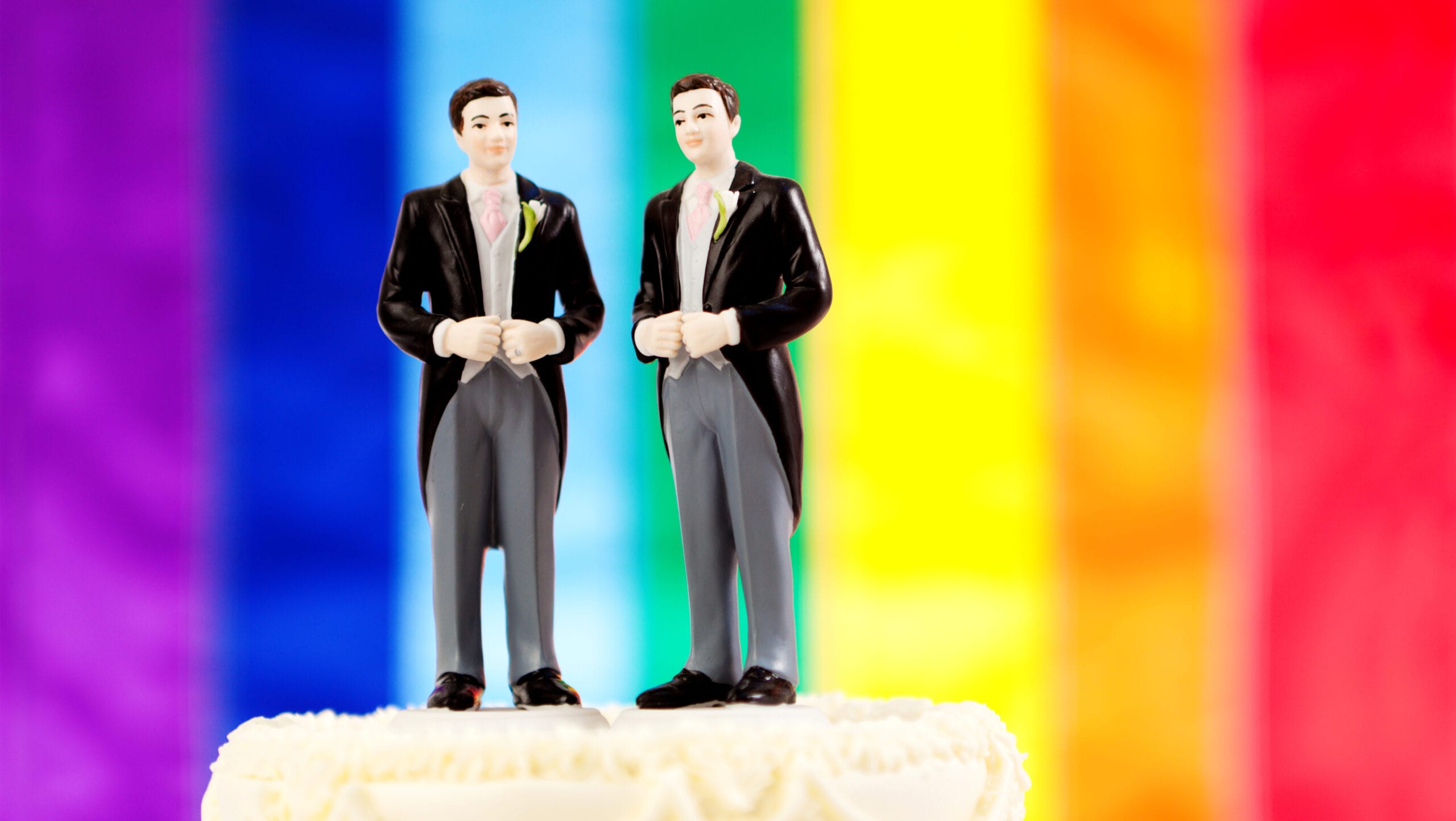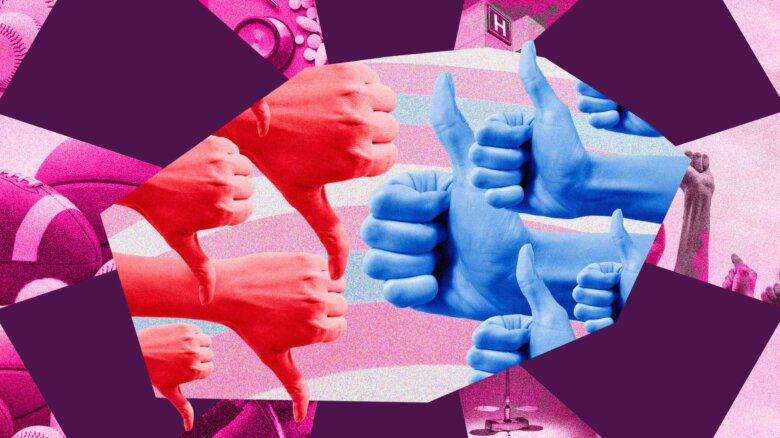When Canada’s Civil Marriage Act (Bill C-38) came into effect on July 20, 2005, making same-sex marriage legal from coast to coast to coast, the country became the fourth in the world to legally treat homosexual couples the same as heterosexual ones. The passage of the act put Canada a decade ahead of our southern neighbour, where the Supreme Court legalized same-sex marriage nationally in 2015, and capped an often-tense debate about the place of queer people in Canadian society. When the Liberal government introduced the legislation that February, then-prime minister Paul Martin declared, “I believe in, and I will fight for, a future in which generations of Canadians to come, Canadians born here and abroad, will have the opportunity to value the Charter as we do today—as an essential pillar of our democratic freedoms.”
But while the passage of the act was a celebratory moment, it did not instantly make all LGBTQ2 Canadians feel equal to their straight counterparts in all aspects of life. Indeed, the symbolism around Bill C-38, which passed in Parliament a few weeks earlier with a vote of 158-133, was perhaps greater than its tangible effects on the everyday life of queer people.
Viewed narrowly, the Civil Marriage Act brought same-sex marriage to Alberta, Prince Edward Island, Nunavut and the Northwest Territories—all the jurisdictions that had not followed Ontario’s lead after the June 10, 2003, decision by the Court of Appeal for Ontario (Halpern v. Canada). The act also had a housekeeping function, changing the definition of “spouse” in various pieces of federal legislation like the Income Tax Act and the Canadian Cooperatives Act.
But more broadly, the legalization of same-sex marriage, and the many dinner-table discussions about it, sped up the already-changing attitudes of straight Canadians toward LGBTQ2 people. “The transformation that occurred from witnessing vows that sound actually the same as straight people’s vows [created the feeling that] we’re all in this together, we’re all expressing the same kind of commitment,” says Martha McCarthy, a Toronto lawyer who has worked on several of the landmark cases that led to the legalization of same-sex marriage in Canada.
“I felt joy. This was a journey we had been on for a long time, that would make a real difference for a lot of people. But it was really anticlimactic,” says Svend Robinson, Canada’s first openly gay member of Parliament. A New Democrat MP from 1979 to 2004, Robinson had been fighting for equality based on sexual orientation in federal law since 1981, when he sat on the committee that wrote the Constitution’s Charter of Rights and Freedoms. (In a painful twist of fate, Robinson left Parliament the year before Bill C-38 was introduced.) “What was so disappointing was that at every step of the way we only made progress because the courts ordered the government to act. They had to be pulled kicking and screaming to the altar.”
After all, relationship recognition had already been gradually granted to same-sex couples over the course of years, through court cases, omnibus bills and low-key policy changes. Adoption by same-sex couples, for example, was legal in Ontario starting in 1995. Queers even had the word “married” already, after a cascade of court rulings that followed Halpern granted the majority of lesbian, gay and bisexual Canadians the right to marry. And in McCarthy’s first big case, M. v H., decided by the Supreme Court of Canada in 1999, she won a ruling that granted same-sex common-law couples the same rights as opposite-sex common-law couples. From there, marriage was a very short step.
The enthusiasm for the Civil Marriage Act was also muted because Martin’s government had seemed so squeamish about their own law. In 2004, before introducing the legislation, the Liberals sent four “reference” questions to the Supreme Court of Canada, asking for advice about how to proceed. One question, asking if “the oppositesex requirement for marriage for civil purposes…. [is] consistent with the Canadian Charter of Rights and Freedoms,” seemed like a sneaky way to appeal the existing court rulings without facing the political storm that would have happened if they did appeal them. The Supreme Court declined to answer that question, forcing the Liberals to make their own move. Martin then allowed a free vote on C-38 among his backbenchers, resulting in about one-third of Liberal MPs voting against the bill, and one cabinet minister, Joe Comuzzi, resigning in opposition.
Even advocates of equal marriage admit the issue may have stolen attention and resources from other LGBTQ2 struggles, like fighting for protections for gender identity and gender expression. “We were fighting for sexual orientation. Gender identity wasn’t even a big issue on the table at that point,” Robinson says. “There’s a collective mea culpa for that. I certainly accept that.”
“What was so disappointing was that at every step of the way we only made progress because the courts ordered the government to act. They had to be pulled kicking and screaming to the altar”
The campaign also upset more radical queers, who thought that the battle for marriage put more conventional, less sexualized middle-class gay and lesbian people in the spotlight, valorizing a patriarchal institution and downplaying issues of sexual freedom. “Because of [the emphasis on] marriage, the public didn’t have to view us just through the lens of sexuality, but it is our sexuality that makes us distinct and worth celebrating,” says Robinson.
While the Civil Marriage Act ended a turbulent chapter of Canadian LGBTQ2 activism, it also demonstrated that equality in law is merely a starting point for fully enfranchising people. Relationship recognition did little to deal with problems like bullying in schools or access to housing. It also did little to improve the lives of people who do not define themselves by their conjugal relationships and those whose gender identity and gender expression exists outside of what heterosexual institutions deem the norm. (Trans and gender non-conforming Canadians would have to wait until 2017 for Justin Trudeau’s Liberal government to add sexual identity and sexual expression to the Canadian Human Rights Code and Criminal Code, via Bill C-16.) Instead, achieving same-sex marriage merely set the stage for future battles for LGBTQ2 Canadians.
Toronto activist and artist Nik Redman was six years into organizing Blockorama, Pride Toronto’s first stage dedicated to Black and other people of colour, when the Civil Marriage Act was passed. “Personally, the whole marriage thing has never been a big I-need-to-do-that, I-want-to-do-that thing,” Redman says. “[But] I do remember DJing a lot of queer weddings after both the Ontario ruling and after the federal law passed. I remember Pride at that time, seeing people who had never come out to Pride before. For them, it was significant.”
As a trans man, Redman considered Bill C-16, which in 2017 recognized sexual identity and sexual expression in federal laws, to be the more substantial gain. “It affects people who don’t even identify as trans, people who might express their gender in many different ways,” he says. “Access to work, to healthcare—those kinds of access issues are more significant to me than whether we’re allowed to get married.”
Bob Gallagher, a long-time gay activist in Toronto who has worked on issues of relationship recognition since the 1980s, says the importance of winning the right to marry was not specifically about marriage itself. For him, it was about how it made straight people think differently about queer people. In subtle ways, because the government had finally voted to recognize us as equal, an employer might be a little bit more likely to hire a queer candidate, a religious congregation more likely to welcome queer members, a teacher more likely to take a stand against bullying, a corporation more likely to sponsor a queer event.
“The tone of Canadian society, the accepted practices within Canadian society, the number of allies that now were open to our community, the institutions you were able to leverage—those things did dramatically change,” Gallagher says. It’s entirely possible that the Civil Marriage Act alerted queers about rights, like adoption or spousal benefits, that they had been discreetly given years earlier but didn’t know about. In the least, it gave them a shorthand to communicate with those who were treating them as less than equal.
And, Gallagher says, the community started to seem more heterogeneous after the 2005 victory. Because of increased mainstream visibility, even indifferent straight Canadians became more aware of the LGBTQ2 community’s many nuances and niches, intersections and tensions.
“Because of increased mainstream visibility, even indifferent straight Canadians became more aware of the LGBTQ2 community’s many nuances and niches, intersections and tensions”
While marriage-minded queers with little personal interest in further social change stepped back from activism, trans people, people of colour and young people, for example, still faced issues that had not been remedied by relationship recognition.
“We have an investment in decolonization and in anti-racism that we haven’t explored and don’t really understand. Legal equality makes all those things easier to accomplish but none of them is easy,” says Alison Kemper, who was half of one of the couples who participated in the Halpern case. She and partner Joyce Barnett married immediately after the Ontario ruling in 2003.
Although the Civil Marriage Act was sold to Canadians based on the idea of equality, not revolution, it probably did open the door to further reinvention of the institution. In a 2007 case known as A.A. v B.B. v C.C. (another case Martha McCarthy & Company had a hand in), the Court of Appeal for Ontario ruled that parenthood is not limited by biology—or to two people. The court said a child could have three legally recognized parents, in that case, the child’s biological mother, her lesbian partner and the child’s biological father. Ontario’s 2016 All Families Are Equal Act was passed to streamline the legalities in establishing parenthood for those who use assisted reproduction to conceive a child. While the act specifically references LGBTQ2 families, it can be just as useful for straight people who use assisted reproduction. Yes, gay marriage did, in the end, change straight marriage.
But other ideas about relationship recognition still remain on the fringes of public policy. One is non-conjugal relationships: Why can’t someone include her sister in her work’s health benefit package, or why can’t a roommate have the right to visit his buddy in intensive care? The COVID-19 shutdown certainly demonstrated that it’s in society’s best interest to give us the power to look after one another, whether we’re coupled up or not. “Opening up rights for people in non-sexual relationships—it’s a perfect time to start doing that,” Gallagher says.
But timing is everything. A more controversial question of relationship recognition, polyamory, is probably a long way from any level of public acceptance, says Gallagher. Despite the existence of respectful queer polyamorous relationships, questions still linger about the unequal power dynamic associated with traditionally religiously straight polygamy (historically, many of these relationships have been tied to abuse). But stranger things have happened.
“There are a whole lot of people who have engaging ideas, who live their lives how they live their lives,” Kemper says. “There’s no reason to say only one way of living is legitimate. At some point their needs may end up in a courtroom.”
The world has changed so much over the past 15 years that people who didn’t live through the same-sex marriage debate are sometimes surprised how much opposition there was and how much homophobic rhetoric was thrown around. But marriage helped deliver what Gallagher and other activists wanted—the hearts of a majority of fellow Canadians. After all, three-quarters of Canadians support gay marriage, according to a 2019 survey by polling firm Research Co.
With same-sex marriage now legal in 30 countries, including our neighbour to the south, Canada does not stand out from the pack as much it used to. But being a frontrunner has had a halo effect in our sense of ourselves and how we’re seen around the world. “Just like our Pride parades in Toronto have been a beacon outside of Toronto, it was a beacon internationally,” Gallagher says.
Expanding the boundaries of what’s legal has expanded our notions of what’s normal, which, in turn, expands our notions of what’s possible.


 Why you can trust Xtra
Why you can trust Xtra


